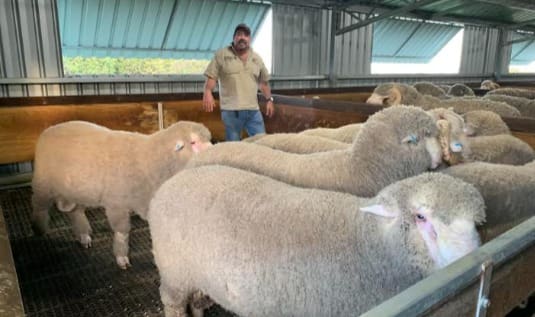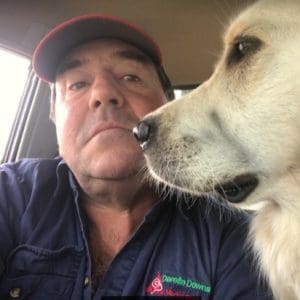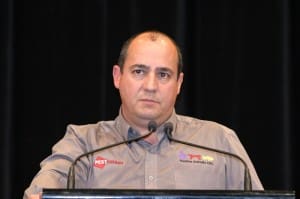
Western Australian Merino breeder Scott Pickering wants MLA to fund the national wild dog co-ordinator role.
MEAT and Livestock Australia has been urged to continue its support for the National Wild Dog Action Plan’s co-ordinator role.
The Centre for Invasive Species Solutions National Wild Dog Management Co-ordinator Project is responsible for delivering the national action plan’s outcomes, by facilitating and maintaining partnerships across all levels of government and industry to reduce wild dog impacts.
However, MLA funding for the co-ordinator project is set to cease at the end of this month, with contributions from other funders, Australian Wool Innovation, and Animal Health Australia – via peak commodity council contributions – only fully financing the role for the first year of its next five-year cycle.
Full financing of the wild dog management co-ordinator project is in doubt from years 2-5. Majority funder AWI has firmly committed to continue contributing in years 2-5, along with AHA. However MLA, although it is funding other wild dog projects, has not yet agreed to continue co-ordinator project funding past 30 June.
The deficit caused by the lack of MLA funding has prompted National Wild Dog Action Plan Co-ordination Committee member Scott Pickering to propose that the impact of wild dogs on red meat producers and the levies collected by MLA justified a continued contribution to the project.

Scott Pickering with Golden Retriever Holly on the look out for wild dogs.
Mr Pickering said he moved a motion at the National Wild Dog Action Plan Coordination Committee meeting in Canberra last week to approach MLA to continue their funding of the co-ordinator project.
“AWI has done a great job in the past and they are still funding the Wild Dog Action Plan group, but it’s about time MLA stepped up and put some money up.”
He said the Northern Territory Cattleman’s Association has estimated wild dogs cost NT cattle producers about $60 million annually. The NWDAP 2020-2030 quotes wild dog livestock predation, disease transmission and control costs as conservatively estimated in 2013-14 to total from $64-$111 million annually.
“We’re only asking for $300,000-$350,000 over the next five years, it’s really only small change to MLA,” Mr Pickering said.
“If wild dogs are costing cattle producers $60 million a year, surely MLA is losing money (due to wild dogs).”

Mr Pickering inspects a wild dog exclusion fence on his Esperance property.
Mr Pickering said support from MLA was needed for adoption programs of wild dog best practice management. He said the plan had best practice extension material, but needed people in the field able to talk and work with growers to deliver on ground programs.
“This should be achievable through producer demonstration sites and be a key target for MLA through their adoption program.
“The National Wild Dog Management Plan co-ordinator has been pivotal in achieving on ground management in the rangelands, but further support will be required inside the agricultural areas where wild dogs are present and programs aren’t well established.”
Mr Pickering said the National Wild Dog Management Plan co-ordinator had generated significant benefits to livestock producers around the country, but wild dogs were becoming prevalent in new and emerging areas.
“Ongoing support through the National Wild Dog Action Plan of the co-ordinator is still required.”
The National Wild Dog Co-ordinator was integral in generating cost benefit ratio between 6.1-16.5 to 1 increase in investment from the National Wild Dog Action Plan 2014-2019. In a review undertaken by Agtrans, it was found that for the $2.62 million invested into the plan by the Federal Government and net present value between $13.31 million and $40.68 million.
MLA is considering the national co-ordination project
An MLA spokesperson said MLA was approached in May 2022 for potential funding opportunities with the National Wild Dog Action Plan, which includes the management co-ordinator role.
“MLA is considering this project through our well established consultation and prioritisation process with the research advisory councils and peak industry councils through the Red Meat Panel.
“These investments are considered in the context of all the top producer priorities that come from that process,” the spokesperson said.
The spokesperson said wild dog baiting, trapping and shooting “is not eligible R&D activity” but MLA recognises the detrimental impact wild dogs have on sheep, goats and cattle and the profitability of the red meat industry.
“MLA currently has two PDS projects in place in regional Victoria, where producers are implementing best management control practices for predation on sheep by wild dogs and other predators.
“In addition, MLA has just completed a wild dog management project in Queensland worth $2.1 million over five years and have received an MDC application for a significant wild dog management project in South Australia.”
The spokesperson said MLA’s role moving forward is to invest in new methods for wild dog control, to drive the adoption of best practice wild dog management based on the latest R&D.
“MLA will consider those investments in line with the well-established governance process and in alignment with the industry and MLA’s strategic priorities.”
The spokesperson said MLA has significantly invested into wild dog research and adoption projects and continues to recognise the impact wild dogs can have on the livestock industry through its long-term and ongoing support of the Centre for Invasive Species Solutions.
“Our investment from 2017 to 2022 is $6.2 million with approximately $2.1 million in wild dog projects.”
Discussions with MLA are ongoing
Centre for Invasive Species Solutions chief executive officer Andreas Glanznig said although an MLA contribution has not been secured for the ongoing co-ordinator project’s next year and for years 2-5, discussions are ongoing.
“This is a strategically really important project and intervention by industry, and more broadly the government, through the National Wild Dog Action Plan.
“It’s a proven success through various evaluations and it is something that is seen as real flagship intervention compared to where we were well over a decade ago when there wasn’t widespread co-operative landscape-scale management of wild dogs,” he said.
He said the co-ordinator project has facilitated the emergence and promotion of cross-tenure wild dog management.
Wild dog role has supported pig, fox, deer and cat programs

National wild dog program co-ordinator Greg Mifsud.
At the committee meeting last week, National Wild Dog Management co-ordinator Greg Mifsud said the role had been successful due to the network and relationships developed across a landscape scale from ground level to regulators.
“A key outcome of this project is that angst, animosity and frustration at a landholder level is taken out of the situation in most cases as people are much more informed and actively involved in the decision making at local, regional and state level.
“The project itself intersects across a range of the Centre for Invasive Species Solutions (CISS) programs covering national best practice, and collaborative pathways to accelerate adoption,” he said.
As the longest serving national feral animal co-ordinator, Mr Mifsud has provided support supervision and mentoring for the national feral pig, feral fox and cat, and deer co-ordinators. He also co-ordinates wild dog and fox management best practice for the MLA projects in Victoria.
Co-ordinators coming to Australian Sheep and Wool Show
National Feral Pig Action Plan co-ordinator Dr Heather Channon and National Feral Cat and Fox Management co-ordinator Gillian Basnett will join Mr Mifsud to speak with landholders, organisations and agencies on multi-species predator management at the Australian Sheep and Wool Show, Bendigo, on 15-17 July.
“Stakeholders tell me there is a significant role for the plan to provide the conduit between research, adaptive management and policy direction,” Mr Mifsud said.
“The goals of the plan are leadership within the community, tools and methods for best practice and increasing awareness and understanding about wild dogs, their impacts and management, and increasing adoption of best practice,” he said.
“The plan does not control wild dogs, but is a strategic document providing the basis for and supporting the management on-ground whilst having influence in terms of ongoing funding leading to wild dog management.
“A lot of focus in the last 10-15 years has been in the sheep and wool industry due to the immediate impact of dogs, so moving forward there are opportunities to work on the impacts on the cattle industry and agriculture more broadly with demonstrations sites evaluating integrated multiple species management.”

I agree with Tony King and Jim Gordon. A growing number of cattle graziers’ are seeing the dingo is an effective land management tool. Evidence from graziers and ecologists indicates that stable family groups of dingoes can regulate the numbers of grazing wildlife. This allows management and resting of total grazing pressure in paddocks, potentially leading to more abundant and higher quality feed for livestock and healthier ecosystems. This can improve long-term landscape and livestock health and productivity resulting in increased financial returns. With growing evidence such as this, no wonder MLA are reluctant to find a wild dog co-ordinator position that does not represent a modern approach to predator management or what their customers want.
The impacts of dingoes on livestock predation can be de-coupled from their abundance through a variety of actions that reduce the vulnerability of livestock to
predation. Globally, producers are moving towards adoption of livestock guardian animals, predator deterrents, temporary electrified fencing and livestock husbandry. These actions reduce or in some case mitigate predation and restores the role of predators in regulating the health and function of ecosystems that underpins Agricultural production.
We have been duped for too long into thinking that killing dingoes will automatically lead to improved agricultural productivity, whereas the research shows that calf loss to dingoes was higher in poison baited areas than non-baited areas. It’s time we modernised Australia’s approach to wildlife management to bring it more in line with global best practice. Rather than shooting, trapping and poisoning dingoes, that has been ongoing for more than 200 years at a significant expense, yet according to graziers the problem is worse than ever. Killing dingoes is counterproductive to protecting livestock.
Say it as it is; dingo control not wild dog control. If you choose to run sheep or cattle in an environment you know has native predators then you should accept any loss to dingo predation as compensation payed for the damage caused by your outdated farming practices.
Stock loss to predation is historically exaggerated with the majority of stock loss caused by poor farming practices and even poorer animal welfare. If you want to graze sheep move to New Zealand, not Australia where sheep and our environment are not compatible. Why should Australia lose an iconic native species for the sake of greedy profit driven sheep graziers?
Tony King, Take a bow, well said. If the decision makers with the Kosciuszko National Park would stop aerial baiting the dingoes and let nature take its course, the dingoes would control the feral pigs, kangaroos, deer, and all the old and weak brumbies.
If you leave the dingoes alone, they will establish their family groups and only the matriarch will breed. They will take up an area and control the problem of the park being destroyed by pigs and too many horses.